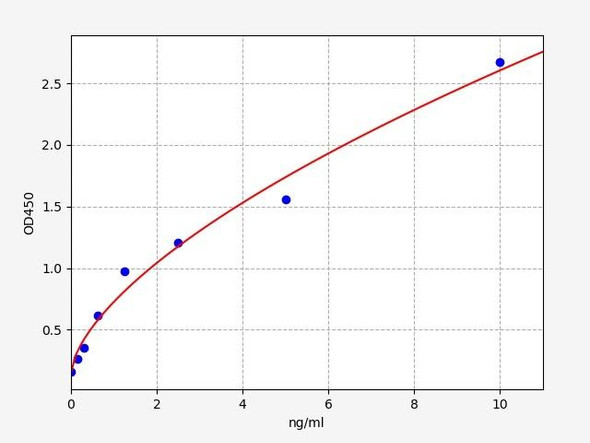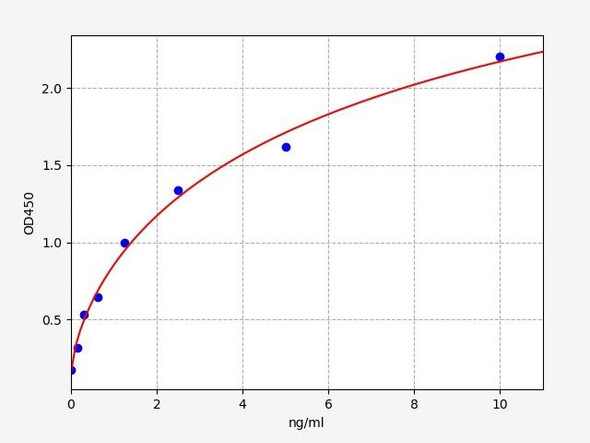Mouse Retinoic acid receptor RXR-alpha (Rxra) ELISA Kit
- SKU:
- MOEB1878
- Product Type:
- ELISA Kit
- Size:
- 96 Assays
- Uniprot:
- P28700
- Range:
- 0.156-10 ng/mL
- ELISA Type:
- Sandwich
- Synonyms:
- Rxra
- Reactivity:
- Mouse
Description
| Product Name: | Mouse Retinoic acid receptor RXR-alpha (Rxra) ELISA Kit |
| Product Code: | MOEB1878 |
| Alias: | Retinoic acid receptor RXR-alpha, Nuclear receptor subfamily 2 group B member 1, Retinoid X receptor alpha, Rxra, Nr2b1 |
| Uniprot: | P28700 |
| Reactivity: | Mouse |
| Range: | 0.156-10 ng/mL |
| Detection Method: | Sandwich |
| Size: | 96 Assay |
| Storage: | Please see kit components below for exact storage details |
| Note: | For research use only |
| UniProt Protein Function: | RXRA: Receptor for retinoic acid. Retinoic acid receptors bind as heterodimers to their target response elements in response to their ligands, all-trans or 9-cis retinoic acid, and regulate gene expression in various biological processes. The RAR/RXR heterodimers bind to the retinoic acid response elements (RARE) composed of tandem 5'-AGGTCA-3' sites known as DR1-DR5. The high affinity ligand for RXRs is 9-cis retinoic acid. RXRA serves as a common heterodimeric partner for a number of nuclear receptors. The RXR/RAR heterodimers bind to the retinoic acid response elements (RARE) composed of tandem 5'-AGGTCA-3' sites known as DR1-DR5. In the absence of ligand, the RXR-RAR heterodimers associate with a multiprotein complex containing transcription corepressors that induce histone acetylation, chromatin condensation and transcriptional suppression. On ligand binding, the corepressors dissociate from the receptors and associate with the coactivators leading to transcriptional activation. The RXRA/PPARA heterodimer is required for PPARA transcriptional activity on fatty acid oxidation genes such as ACOX1 and the P450 system genes. Homodimer. Heterodimer with RARA; required for ligand- dependent retinoic acid receptor transcriptional activity. Heterodimer with PPARA (via the leucine-like zipper in the LBD); the interaction is required for PPARA transcriptional activity. Also heterodimerizes with PPARG. Interacts with NCOA3 and NCOA6 coactivators. Interacts with FAM120B. Interacts with PELP1, SENP6, SFPQ, DNTTIP2 and RNF8. Interacts (via the DNA binding domain) with HCV core protein; the interaction enhances the transcriptional activities of the RXRA/RARA and the RXRA/PPARA heterodimers. Interacts with PRMT2. Interacts with ASXL1 and NCOA1. Highly expressed in liver, also found in lung, kidney and heart. Belongs to the nuclear hormone receptor family. NR2 subfamily. |
| UniProt Protein Details: | Protein type:DNA-binding; Nuclear receptor; Motility/polarity/chemotaxis Chromosomal Location of Human Ortholog: 9q34.3 Cellular Component: nucleoplasm; nuclear chromatin; nucleus; receptor complex Molecular Function:ligand-dependent nuclear receptor activity; zinc ion binding; chromatin DNA binding; transcription coactivator activity; protein binding; enzyme binding; DNA binding; retinoid-X receptor activity; vitamin D receptor binding; protein heterodimerization activity; sequence-specific DNA binding; steroid hormone receptor activity; retinoic acid receptor activity; transcription factor activity Biological Process: retinoic acid receptor signaling pathway; transcription initiation from RNA polymerase II promoter; cholesterol metabolic process; camera-type eye development; response to retinoic acid; vitamin metabolic process; in utero embryonic development; ventricular cardiac muscle cell differentiation; negative regulation of transcription from RNA polymerase II promoter; cellular lipid metabolic process; positive regulation of translational initiation by iron; protein homotetramerization; virus-host interaction; ventricular cardiac muscle morphogenesis; positive regulation of transcription from RNA polymerase II promoter; steroid hormone mediated signaling; gene expression; transmembrane transport; embryo implantation; maternal placenta development |
| NCBI Summary: | Retinoid X receptors (RXRs) and retinoic acid receptors (RARs) are nuclear receptors that mediate the biological effects of retinoids by their involvement in retinoic acid-mediated gene activation. These receptors function as transcription factors by binding as homodimers or heterodimers to specific sequences in the promoters of target genes. The protein encoded by this gene is a member of the steroid and thyroid hormone receptor superfamily of transcriptional regulators. Alternative splicing of this gene results in multiple transcript variants. [provided by RefSeq, May 2014] |
| UniProt Code: | P28700 |
| NCBI GenInfo Identifier: | 133701 |
| NCBI Gene ID: | 6256 |
| NCBI Accession: | P19793.1 |
| UniProt Secondary Accession: | P28700,P28700, Q05343, |
| UniProt Related Accession: | P19793 |
| Molecular Weight: | 51kDa |
| NCBI Full Name: | Retinoic acid receptor RXR-alpha |
| NCBI Synonym Full Names: | retinoid X receptor alpha |
| NCBI Official Symbol: | RXRA |
| NCBI Official Synonym Symbols: | NR2B1 |
| NCBI Protein Information: | retinoic acid receptor RXR-alpha |
| UniProt Protein Name: | Retinoic acid receptor RXR-alpha |
| UniProt Synonym Protein Names: | Nuclear receptor subfamily 2 group B member 1; Retinoid X receptor alpha |
| Protein Family: | Retinoic acid receptor |
| UniProt Gene Name: | RXRA |
| UniProt Entry Name: | RXRA_HUMAN |
| Component | Quantity (96 Assays) | Storage |
| ELISA Microplate (Dismountable) | 8×12 strips | -20°C |
| Lyophilized Standard | 2 | -20°C |
| Sample Diluent | 20ml | -20°C |
| Assay Diluent A | 10mL | -20°C |
| Assay Diluent B | 10mL | -20°C |
| Detection Reagent A | 120µL | -20°C |
| Detection Reagent B | 120µL | -20°C |
| Wash Buffer | 30mL | 4°C |
| Substrate | 10mL | 4°C |
| Stop Solution | 10mL | 4°C |
| Plate Sealer | 5 | - |
Other materials and equipment required:
- Microplate reader with 450 nm wavelength filter
- Multichannel Pipette, Pipette, microcentrifuge tubes and disposable pipette tips
- Incubator
- Deionized or distilled water
- Absorbent paper
- Buffer resevoir
*Note: The below protocol is a sample protocol. Protocols are specific to each batch/lot. For the correct instructions please follow the protocol included in your kit.
Allow all reagents to reach room temperature (Please do not dissolve the reagents at 37°C directly). All the reagents should be mixed thoroughly by gently swirling before pipetting. Avoid foaming. Keep appropriate numbers of strips for 1 experiment and remove extra strips from microtiter plate. Removed strips should be resealed and stored at -20°C until the kits expiry date. Prepare all reagents, working standards and samples as directed in the previous sections. Please predict the concentration before assaying. If values for these are not within the range of the standard curve, users must determine the optimal sample dilutions for their experiments. We recommend running all samples in duplicate.
| Step | |
| 1. | Add Sample: Add 100µL of Standard, Blank, or Sample per well. The blank well is added with Sample diluent. Solutions are added to the bottom of micro ELISA plate well, avoid inside wall touching and foaming as possible. Mix it gently. Cover the plate with sealer we provided. Incubate for 120 minutes at 37°C. |
| 2. | Remove the liquid from each well, don't wash. Add 100µL of Detection Reagent A working solution to each well. Cover with the Plate sealer. Gently tap the plate to ensure thorough mixing. Incubate for 1 hour at 37°C. Note: if Detection Reagent A appears cloudy warm to room temperature until solution is uniform. |
| 3. | Aspirate each well and wash, repeating the process three times. Wash by filling each well with Wash Buffer (approximately 400µL) (a squirt bottle, multi-channel pipette,manifold dispenser or automated washer are needed). Complete removal of liquid at each step is essential. After the last wash, completely remove remaining Wash Buffer by aspirating or decanting. Invert the plate and pat it against thick clean absorbent paper. |
| 4. | Add 100µL of Detection Reagent B working solution to each well. Cover with the Plate sealer. Incubate for 60 minutes at 37°C. |
| 5. | Repeat the wash process for five times as conducted in step 3. |
| 6. | Add 90µL of Substrate Solution to each well. Cover with a new Plate sealer and incubate for 10-20 minutes at 37°C. Protect the plate from light. The reaction time can be shortened or extended according to the actual color change, but this should not exceed more than 30 minutes. When apparent gradient appears in standard wells, user should terminatethe reaction. |
| 7. | Add 50µL of Stop Solution to each well. If color change does not appear uniform, gently tap the plate to ensure thorough mixing. |
| 8. | Determine the optical density (OD value) of each well at once, using a micro-plate reader set to 450 nm. User should open the micro-plate reader in advance, preheat the instrument, and set the testing parameters. |
| 9. | After experiment, store all reagents according to the specified storage temperature respectively until their expiry. |
When carrying out an ELISA assay it is important to prepare your samples in order to achieve the best possible results. Below we have a list of procedures for the preparation of samples for different sample types.
| Sample Type | Protocol |
| Serum | If using serum separator tubes, allow samples to clot for 30 minutes at room temperature. Centrifuge for 10 minutes at 1,000x g. Collect the serum fraction and assay promptly or aliquot and store the samples at -80°C. Avoid multiple freeze-thaw cycles. If serum separator tubes are not being used, allow samples to clot overnight at 2-8°C. Centrifuge for 10 minutes at 1,000x g. Remove serum and assay promptly or aliquot and store the samples at -80°C. Avoid multiple freeze-thaw cycles. |
| Plasma | Collect plasma using EDTA or heparin as an anticoagulant. Centrifuge samples at 4°C for 15 mins at 1000 × g within 30 mins of collection. Collect the plasma fraction and assay promptly or aliquot and store the samples at -80°C. Avoid multiple freeze-thaw cycles. Note: Over haemolysed samples are not suitable for use with this kit. |
| Urine & Cerebrospinal Fluid | Collect the urine (mid-stream) in a sterile container, centrifuge for 20 mins at 2000-3000 rpm. Remove supernatant and assay immediately. If any precipitation is detected, repeat the centrifugation step. A similar protocol can be used for cerebrospinal fluid. |
| Cell culture supernatant | Collect the cell culture media by pipette, followed by centrifugation at 4°C for 20 mins at 1500 rpm. Collect the clear supernatant and assay immediately. |
| Cell lysates | Solubilize cells in lysis buffer and allow to sit on ice for 30 minutes. Centrifuge tubes at 14,000 x g for 5 minutes to remove insoluble material. Aliquot the supernatant into a new tube and discard the remaining whole cell extract. Quantify total protein concentration using a total protein assay. Assay immediately or aliquot and store at ≤ -20 °C. |
| Tissue homogenates | The preparation of tissue homogenates will vary depending upon tissue type. Rinse tissue with 1X PBS to remove excess blood & homogenize in 20ml of 1X PBS (including protease inhibitors) and store overnight at ≤ -20°C. Two freeze-thaw cycles are required to break the cell membranes. To further disrupt the cell membranes you can sonicate the samples. Centrifuge homogenates for 5 mins at 5000xg. Remove the supernatant and assay immediately or aliquot and store at -20°C or -80°C. |
| Tissue lysates | Rinse tissue with PBS, cut into 1-2 mm pieces, and homogenize with a tissue homogenizer in PBS. Add an equal volume of RIPA buffer containing protease inhibitors and lyse tissues at room temperature for 30 minutes with gentle agitation. Centrifuge to remove debris. Quantify total protein concentration using a total protein assay. Assay immediately or aliquot and store at ≤ -20 °C. |
| Breast Milk | Collect milk samples and centrifuge at 10,000 x g for 60 min at 4°C. Aliquot the supernatant and assay. For long term use, store samples at -80°C. Minimize freeze/thaw cycles. |










